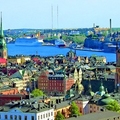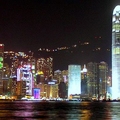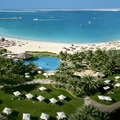Destinations / The best capital cities in the world / Sophia
Sophia
About Sophia
Sophia is the capital of Bulgaria and one of the most beautiful capital cities of the world. From the Greek word “ Σοφία” means “mastery," and "wisdom". The city is located in the Western Bulgaria, at the northern foot of the Vitosha mountain, in the Sofia Valley that is surrounded by Sophia mountains on all sides.
Sophia is a young European capital. The city has a population of 1,270,284 people. Sophia has about 1/6 Bulgarian manufacturing areas (engineering, metallurgy, chemical, rubber, pulp and paper, food, light industry). We can see the Bulgarian Academy of Sciences, universities, theaters, art galleries and museums there. Archaeological traces showing that Sophia was inhabited seven thousand years ago were founded, that’s why Sophia is one of the oldest cities in Europe. It gained several names over the time. According to the archaeologists’ testimony, people lived here from the Neolithic period. The reason for such an early settlement is possible because of the mineral springs of the basin. The capital contains many salts, the healing water reaches a temperature of 21-42 degrees Celsius. Sofia was originally a Thracian settlement called Sardica. It was captured by the Romans in 1929 and became the capital of the Mediterranean Dacia. During the Ottoman rule the town became an important center of the empire. The city developed rapidly, and the Ottoman Empire gained even greater importance. Occupied by the Russians in 1878 it became the capital of independent Bulgaria in 1879.
Major attractions in Sophia
The St. Sophia Cathedral
The St. Sofia Cathedral is located in the heart of the Bulgarian capital -Sophia. The first church was built at this place in 311-313 years. Subsequently, with the support of the Emperor Constantine the first , the Cathedral of St. Sophia was erected, where the Serdikiysky Cathedral was held in 343. In 537, the Emperor Justinian the Great restored the affected Cathedral after the barbarian invasions and the basilica of Constantinople, together with the imperial cathedral, which he also raised, referred to her "Our Lady of Wisdom". The temple is preserved and it is 1,700 years old. It held Orthodox services, although in the time of the Turkish rule it was turned into a mosque for some time and in the middle of the XIX century the Ottomans used the church for their fire service center of the city. In the XIII century people began to call the city “ Sophia” by its name and at the second half of the XIV century the city became officially known as "Sophia" in the charters of the Bulgarian kings.
The National Gallery of Art
The National Gallery of Art was founded in 1948 and it is located in the former royal palace on the "Prince Alexander of Battenberg” square. Visitors can see works by the Bulgarian artists from the Renaissance period until the end of the XX century. Among these works there are works of : Zachary Zograf, Zlata Boyadjiev, IvanMilev, Vladimir Dimitrov-Maistora. The gallery often hosts seminars, concerts and conferences in its halls where you can see works of many painters and sculptors.
The Antique Serdica Fortress - Zagora
This is an archaeological reserve with a modern road and pavement in the center of the Bulgarian capital Sophia. It holds the ruins of a Thracian antiquity to the late middle ages. The Rotunda of St. George was uncovered and exposed in the IV century.
The “ Ivan Vazov” Theatre
The Theatre is also a symbol of the capital. There were three contenders for the title character of the building of the National Assembly. There was a monument of the Russian King - Alexander II acrosas it. Noteworthy are the Bulgarian Academy of Sciences and Sophia.
We can admire a lot of museums in Sophia. There are a lot of art galleries, archaeological and ethnographic museums, the Museum of Sofia, as well as the Central Museum of the City among them. There are also many house-museums of some prominent citizens.
The Nevsky Cathedral
The symbol of Bulgaria's capital known as '' heart of the city'' Alexander Nevsky Cathedral is one of the largest Orthodox cathedrals. Built in Byzantine style the architecture of the Cathedral brings rather a mosque, impressing with blue and gold domes. It took 30 years to build them, working only 45 artists to decorate the interior walls with Italian marble, alabaster from Egypt, Brazilian onyx, gold, huge frescoes and chandeliers. The cathedral offers a collection of approximately 1,500 images to the visitors today.
Nightlife in Sophia
Sophia is a city with a spectacular nightlife, packed with clubs, bars, pubs and restaurants and many outdoor concerts. The city has many parks and it is a great place to relax. The Vitosha Boulevard - named by Bulgaria and Vitoshka is the 22nd places on the list of the most expensive shopping streets in Europe. It represents an artery with numerous luxury shops and exhibitions of famous designers. The fact that the city is situated at the foot of Vitosha mountain adds a specific ingredient to the generally charm of the Bulgarian capital.
In the center of Sophia we can admire the Synagogue. Sophia has a sizeable importance for the Jewish population since the 1950. They came here most during the Ottoman occupation when the Turks were driven out of town. Although Jews were never persecuted in Bulgaria after the war many of them immigrated to Israel, but the synagogue represents the wealth and the influence that they exercised it once here. It is the third largest synagogues in Europe, only those in Amsterdam and Budapest are higher. Visitors are welcome to admire its elegant pleasant views. The building follows a Moorish design oriented around the central dome. The interior is decorated in fine style, the most important being that two tons of chandelier illuminate the main hallway. A small museum displays a collection of artifacts taken from the disappearance of the Jewish communities from all over Bulgaria.
St. George Rotunda is the oldest building in Sophia, the building has more than 1,600 years. It is a small courtyard behind the Sheraton Hotel, surrounded by three sides. Although such a building is strangely out of place, a rotunda church itself is tremendous, keeping the gravity that more modern buildings cannot match. Built of brick, as the name suggests most of the building is a circular chapel, with small rectangular extensions providing inputs to the main points. The Romans built the first building in the 4th century and it was restored by the Byzantine emperor Justinian 200years later. During the Turkish occupation the building served as a mosque, but it was replaced back in a church in the 19th century .Beautiful frescoes founded in the city can be found inside the mosque. They became impressive because of their considerable length.
National History Museum is an institution of excellence. It is housed near the former Bulgarian Communist Party Headquarters. The museum owns more than half a million objects and artifacts. With over 30 permanent exhibition halls that contain galleries they include all important events in the Bulgarian history. Notable exhibits include Rogozen treasurea. These 165 silver objects were unearthed in 1986 near the village Rogozen and it is the largest discovery of Thracians objects ever made. The Bulgarian medieval art collection is also fascinating.
St. Kliment Ohridski University has a long tradition of 120 years of activity. It was the first university in Bulgaria. The college is the best maintained in Europe. The faculty has benches for those waiting at the doors to enter the course. We have to mention the existence of a student canteen. And if you want something else then there are special places around the college for students with food at very good prices. They are called "studentski flock" means "student restaurant". The university gives many possibilities for students.
The National Archaeological Museum in Sofia houses a mosque dating from the fifteenth century. Here you can admire the pieces of Thracian, Greek and Roman architecture. One of the main attractions of the museum is a treasure which consists of 13 vessels of solid gold and decorated with bizarre shapes.
The City Park is the oldest park in the Bulgarian capital Sofia, located in the city center to the former royal palace. It was opened officially on April 4, 1878 and it is originally called the Alexandrovska garden. It is a very beautiful and popular place in Sophia. Near the Central Park are the Bulgarian National Bank, "Bulgaria" Hall, the Ministry of Defence, National Theatre "Ivan Vazov", the Ministry of Transport, the new "Grand Hotel Sofia," City Art Gallery. It is a popular place to play chess outdoors in Sofia. Battenberg Mausoleum is the resting place of Prince Alexander I of Bulgaria (1857-1893), who was the first modern head of the state of Bulgaria.
The Royal Palace was built as the headquarters of the Ottoman police. In 1873 it was subject to a torture. Vasil Levski, the Bulgarian national hero was publicly executed. After the liberation from Turkish rule, the building was rebuilt in Venetian style, and in 1887, not afraid of his recent dark past, the Prince Alexander of Battenberg moved here, after which the palace was the official residence of the Bulgarian royal family, until the Communist takeover. The Royal Palace hosts the National Art Gallery and the Ethnographic Museum, and in a shady park, located in his rear, contains a collection of statues.
The Mineral Baths also known as "Turkish Bath", was built between 1911 and 1913. This elegant building with a striped facade and ceramic decoration, with a reminiscent design of the medieval churches of Nessebar is one of the architectural gems of Sofia, but in 1990 it fell into decline and it had been restored more than ten years. When the reconstruction of this building was finally completed, it was planned to accommodate the Civic Museum, although the specific date of its opening had not been established yet. In the central part of a small area located between the bath and the Mosque Banya Bashi, called the area of Bansko is a modern fountain. Near the Mineral Baths an elegant complex of fountains with drinking water was built, where the locals come with empty bottles to fill them with mineral water.
The National Palace of Culture is the largest multifunctional complex in the south-eastern Europe. The building, constructed in the style of the Soviet era, is known for an extensive calendar of cultural events. It is located in the heart of a lush park, with a magnificent view of Vitosha Mountain. The National Palace of Culture has 16 rooms that accommodate from 50 to 4,000, as well as several cafes, bars, restaurants, nightclubs and shops. It is surrounded by museums, historical and cultural sites, financial institutions, as well as the best metropolitan hotels and restaurants.
The Sofia National Opera and Ballet Theatre was founded in 1890 in line with Western European and Russian traditions of theatrical opera. Each season the theater company's constant soloists, orchestral musicians, dancers and theater directors to the public premiere of opera and ballet performances and concerts. In addition, the National Opera and Ballet Festival is held every Easter with gala performances and participation of famous Bulgarian composers who create new national works. Many great artists began their career in this theater.
In Sophia the national souvenirs are embroidered clothes, homespun rugs, linen, handicrafts of leather, silver and copper, and of course, the famous rose oil and perfume on the basis of the Valley of Roses. Sofia will surprise you for sure and will be remembered for a variety of national cultures, eclectic architecture, and the diversity of historical and cultural monuments. It is the place where during the year it is organized international concerts and festivals. Sofia has an international and domestic airport very comfortable for such city. Sofia is a very interesting city. Views and entertainments available to this amazing place attract many tourists. The culture and the history is felt due to the ruins and the monuments of the city. Sophia is also famous for its romantic parks where love gathers many lonely hearts.
Others The best capital cities in the world .
Others from The best capital cities in the world
Who doesn't wish for an exciting vacation or who isn't attracted by fascinating experiences? This poll provides comprehensive information about the best, most important capital cities in the world that we generally recommend as wonderful places to explore.
Let them be your starting point and consider these places might occur to you and suit your goals.
These are the most liveable,friendly and multicultural cities on Earth, with the most exciting cultures,with the most beautiful beaches, with the most lively nightlife and the most beautiful scenery.
Explore the cities and find out the best kept secret of each of them.
I'm sure you'll experience senses to the fullest intensity.



















